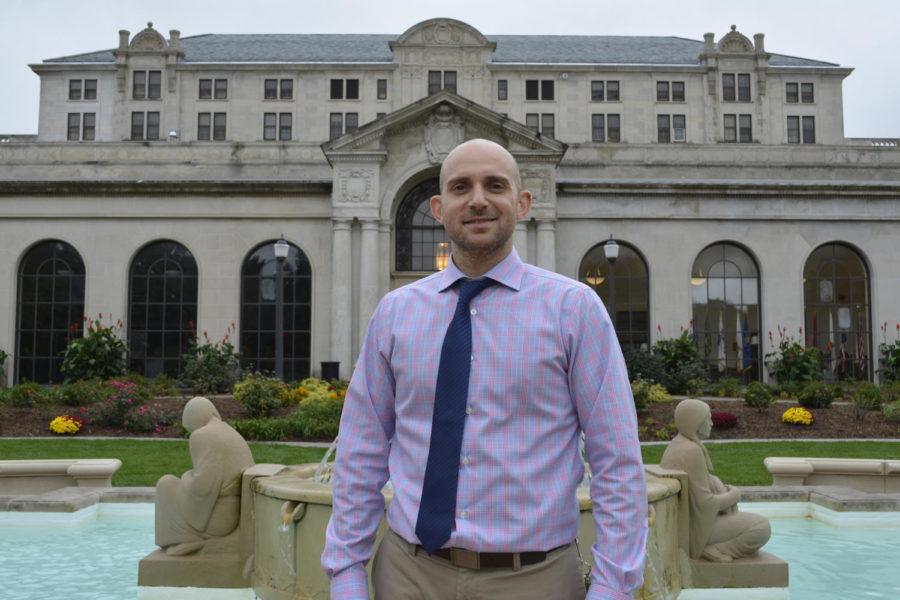The Student Activities Center: the people behind your favorite clubs and organizations
Katlyn Campbell/Iowa State Daily
George Micalone, Director of Student Activities and Assistant Director of the Memorial Union, started working at Iowa State nearly a decade ago. Micalone oversees Student Union Board (SUB) and Student Organizations. Micalone works to provide resources to SUB and Student Organizations when they need their questions answered. He also helps student create new student organizations.
October 3, 2017
The Student Activities Center (SAC) buzzes with excitement as students and faculty alike breeze past the cubicles and cramped offices in the East Student Office Space beneath the Memorial Union.
Despite it being a weekday morning, this is not unusual for the SAC. They handle about 160,000 interactions annually with students, not to mention the administrative duties of hundreds of clubs, organizations and programs such as Cyclone Cinema and ISU AfterDark.
In the SAC, the seven full-time staff members and five graduate assistants work to keep everything running efficiently.
George Micalone is the man in charge. As the director of student activities and the assistant director of the Memorial Union, Micalone’s primary job is to deal with issues relating to student organizations and respond to any of their questions.
He is also the person to go to if someone wants to create a new organization and can function like a student advisor, helping students vet ideas and come up with solutions to their problems. However, he often has to give students answers that they don’t want to hear.
“Sometimes I have students that are super passionate about their idea and you have to figure out how to get them down from cloud nine in a nice way,” Micalone said. “Sometimes that’s the only interaction I have between students, and that’s the unfortunate part of my job.”
When Micalone first started nearly a decade ago, there were only about 550 clubs and organizations at Iowa State. But as enrollment grew over the years, so did the number of clubs and organizations. There are now more than 850 clubs at Iowa State and the number is still rising.
“We’ve been over 900 a few times the past six months, but because we haven’t been consistently over 900, we aren’t promoting 900-plus,” Micalone said.
That number rises and falls, with 30 to 40 clubs and organizations being lost every year compared to the 40 to 50 gained. Despite that, Micalone remains optimistic about the trajectory of student organizations.
“I would imagine by the end of this year, we will be promoting 900-plus,” Micalone said.
The amount of clubs and organizations at Iowa State is significant compared to schools that are similar in size. The University of Iowa only has about 500, and Iowa State has nearly twice the amount of recognized organizations as Oklahoma University and Texas Tech. Even so, Iowa State’s SAC does exercise a fair amount of scrutiny in the creation of new organizations.
“If we were just accepting anyone who was following our process, we would be well over a thousand,” Micalone said.
Just last year, there were 3,000 events submitted to the event authorization system for approval. At any given time there are over 100 pending events.
Tim Reuter, the Student Organizations resource coordinator, works with students to make sure that any events they want to put on are safe and abide by all university policies. When organizations want to have an event, they can request it to be waived through the online event authorization system; a system that is fairly unique compared to other universities.
“Our system really does help student organizations get connected to different departments and different resources on campus to make sure that their events are safe and adhering to guidelines,” Reuter said. This ultimately makes it much more efficient than previous paper trails or verbal communication.
The significant logistical challenge for the small SAC staff to monitor all those clubs and organizations at Iowa State means that the student organizations are free to be self-regulated.
“We manage the recognition process but we leave it up to the orgs to manage themselves,” Reuter said. “We will provide all the resources we can to them, but it’s really up to the orgs to choose how they want to go about achieving their vision.”
While the hands-off approach currently works for the SAC and student organizations, Micalone would like to eventually shift the SAC into a more integrated role. He explained that the SAC is more reactive than proactive in their approach with student organizations, by virtue of the sheer amount of organizations compared to the number of SAC staff.
“We don’t like being involved in that regard, when you start and when you are in trouble. We want to be involved more than that and we don’t have the staff to do that,” Micalone said.
Besides working with the event authorization system, Tim Reuter also works with the student organization marketplace, where organizations can sell event registrations, collect membership dues and receive non-charitable funds online. Naturally, it is challenging to keep everyone in the SAC on the same page when there is so much going on.
“Really what it comes down to in our office is just making sure that we are communicating with each other,” Reuter said. “That we are talking to the right people who need to be informed and asking the right questions.”







